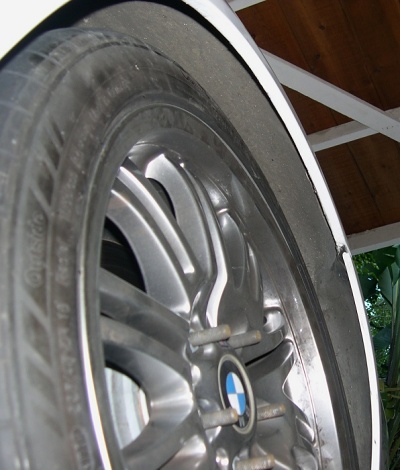|
|
| Rolling the Rear Fender Lips |
|
|
|
|
|
| Rolling the Rear Fender Lips |
|
|
|
The rear fender lips on the rear of the E46 M3 are quite thick. I measured them at 0.77 inches from outer to inner edge. As a result, when you install wider wheel and tires, and lower the car, it is quite possible that the outer edge of the rear tire will start to rub on the inside of the fender lip when cornering or going over bumps. Evidence of this having happened on my car can be seen in the photo below: |

|
|
Much of the paint on the inside of the fender lip has been rubbed off. This is with 275 mm tires and 10 inch wheels. There are two solutions. One can literally cut the inner edge of the fender lip off. This can be done with a cut-off wheel. The result is good in terms of the clearance created. But it tends to weaken the rear quarter panel, so you want to be careful not to lean against it (or let anyone else lean against it). The cutting method is what I chose to do on my E30 M3. I had to take some time to paint the bare metal edge that was left after cutting to prevent rust from setting in. The second option is to roll the fender lips upwards and inwards. This can be done with a special machine designed for the purpose. This tool bolts onto the hub and uses a poly-urethane wheel on an adjustable arm which is rolled back and forth to modify the shape of the lip. However, shops that have these (expensive) tools are often unwilling to use them on non-customer cars. This is the case with the two shops in my area of West LA (CEC and Globe Tire). But you can roll the fenders yourself with a little perseverance. This is usually done with a length of wood (some folks use a baseball bat). I did not invent this, it is a well known technique. The basic idea is to place the wood dowel between the tire and the fender lip, and then, while applying pressure against the lip, have an accomplice roll the car forward and back, all the while rolling the dowel along the fender. |

|
|
I used a 2.00" diameter Maple dowel. Oak would also work well. Pine would be a poor choice, it is not hard enough and would most likely splinter. There is one important factor to making this work. You have to be able to get the dowel in between the fender and the tire! I found that installing a factory 18" front wheel and tire gave just about the right amount of space. I added a 5mm spacer to make the clearance even better. I could just squeeze the wooden dowel in between the tire and fender lip. |

|
|
Using this technique I was able to reduce the thickness of the fender lip from 0.77" to about 0.55" which is a significant improvement, almost a quarter inch. Note: there is factory caulking inside the fender lip (in the valley between the lip and the outer fender). To get satisfactory results when rolling the fender lip it is better to remove this caulking. It can be scraped out with a screw driver or similar tool. On my particular car this caulking was only found on the very back part of the fender, near the plastic rear bumper. But other cars may have more of it. Caution: there is a risk of cracking the paint along the edge of the fender lip when performing this procedure. Use a heat gun to warm up the paint before rolling and you will have less chance of cracking, but there is no guarantee. I did crack the paint on one side over a 1cm section, but this was partly due to the paint having been damaged previously by rubbing tires. A little touch up paint is all that was needed to correct the situation. |
|